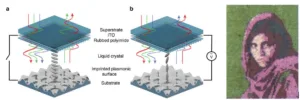A target for some time has been a fabric that can be made to change color and pattern at will. Recent developments reported by researchers at the University of Central Florida (Orlando, FL) seems to bring such a capability closer to reality. A team led by Debashis Chanda of the University’s NanoScience Technology Center and the College of Optics and Photonics (CREOL) has developed an approach for producing a very thin, very flexible, reflective, full-color display.
The most recent results reported by the team were published in the cover article of the June 11th edition of Nature Communications. The article is entitled “Polarization-independent actively tunable colour generation on imprinted plasmonic surfaces” and is available online here.
The display developed by the team does not need its own light source. Rather, it reflects ambient light. Based on the use of nanostructured metallic surfaces, so-called structural color offers many benefits compared to conventional pigmentation-based display technologies. One such advantage is the potential to provide energy and cost savings. In the past, one limitation with such an approach has been that, once these structures are fabricated, their optical characteristics are fixed and cannot change.
This most recent work uses a specially designed “nanostructured plasmonic surface” in conjunction with high birefringence liquid crystals to demonstrate a tunable polarization-independent reflective surface. The color reflected by the surface can be changed by the application of a voltage.
The device developed by the team consists of a thin layer of liquid crystal placed over a metallic nanostructure shaped like a microscopic egg carton. Such a surface absorbs some light wavelengths and reflects others. The surface is created through the use of a simple and inexpensive nano-imprinting technique that can produce the reflective nanostructured surface over a large area. The colors reflected by the surface can be controlled by the voltage applied to the liquid crystal layer. More specifically, the wavelength of the absorption depends on the liquid crystal orientation near the interface which, in turn, depends on the electric field applied across the device.
One of the team members stated that “In combination with imprinted structures of varying periods, a full range of colors spanning the entire visible spectrum is achieved, paving the way towards dynamic pixels for reflective displays”.
The display produced in this manner is only a few microns thick. Such an ultrathin display, the team suggests, can be applied to flexible materials like plastics and synthetic fabrics. More than that, the team represents that their approach has the potential to be “a cheap way of making displays on a flexible substrate with full-color generation”.
Initial research by the team was funded by the university and grants from the Florida Space Institute/NASA. The program was just awarded a $300,000 grant from the National Science Foundation to continue research.
Commercialization of the technology may be a way off since it will require further development in ancillary technologies such as flexible circuitry and batteries. – Arthur Berman

